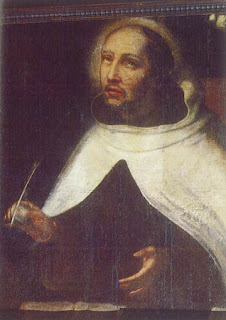- He was born around 1542 in Spain to a family which had converted from Judaism to Christianity. He was given the name Juan de Yepes y Alvarez.
- His father, Gonzalo, was an accountant and worked for rich relatives who were silk merchants. When Gonzalo married Catalina, a lower class orphan, his family cut him off and he had to work as a weaver to make ends meet. Hence the family were poor. Gonzalo died when John was about three.
- Hence John was educated in a school for poor children, which focused mainly on teaching Christian doctrine. He became an altar boy at a nearby monastery and later went on to study humanities at a Jesuit school.
- He joined the Carmelite order in 1563 and took the name John of St Matthias. In 1567, he was ordained as a priest.
- He felt drawn to join a stricter order, the Carthusians, who led a silent, contemplative life, but before he could do that, he met Teresa of Avila, who was working to bring the Carmelite order back to a stricter rule, and asked for John's help. Her rule proscribed spending most of the day in prayer, study and solitude, periods of fasting and abstaining from meat altogether. There was also a rule against wearing covered Shoes. This was when John changed his name to John of the Cross, and went on to found a monastery, the first for friars wishing to follow Teresa's rule.
- He is considered to be one of the foremost Spanish poets. It is from one of his works that we get the phrase "Dark night of the soul". He is one of the 36 doctors of the church.
- He once had a vision of the crucified Christ, which inspired him to make a drawing of Christ on the cross from above. This drawing inspired Salvador Dali's work, Christ of St John of the Cross.
- St John of the Cross is the patron of peole who lead a contemplative life, mystics, mystical theology and Spanish poets.
- He died of a severe skin infection on 14 December 1591. The following morning, people clamoured to view his body. Many of them managed to obtain pieces of his habit to take home.
- As is often the case with saints, there was some wrangling afterwards about where his body should be laid to rest. In Ubeda, where he'd gone for treatment and where he died, or Segovia, where he'd helped found a monastery? It ended with a petition to the Pope and eventually a compromise was reached. Ubeda could keep an arm and a leg and the rest of St John should be moved to Segovia. During the journey, one of St John's arms was removed to be kept in Madrid.
Golden Thread
Terry Kennedy is inexplicably and inexorably drawn to the small town of Fiveswood as a place to live and work after university. He is sure he has never visited the town before, but when he arrives there, it seems oddly familiar.
Fiveswood has a rich and intriguing history. Local legends speak of giants, angels, wolves, a local Robin Hood, but most of all, a knight in golden armour. Fiveswood's history also has a dark side - mysterious deaths blamed on the plague, a ghostly black panther, and a landslide which buried the smugglers' caves.
Terry buys an apartment in The Heights, a house which has been empty for decades, since the previous owner disappeared. Now he has finally been declared dead, developers have moved in and turned it into six flats. Terry has the odd feeling he has lived in this enigmatic house before. But that is not all. Since childhood, Terry has had recurring, disturbing dreams which have been increasing in frequency so that now, he has them almost every night. To his dismay, the people from his nightmares are his new neighbours.
Except, that is, for Eleanor Millbrook. She is refreshingly unfamiliar. After Terry saves her from a mysterious attacker, they become close. However, Terry's nightmares encroach more and more on his waking life, until they lead him to a devastating discovery about who he really is.
Available on Amazon:
Available on Amazon:
Paperback
Kindle


No comments:
Post a Comment